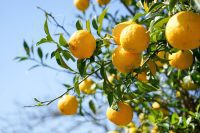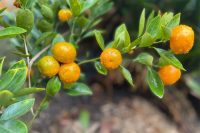What is sudachi?
Sudachi (Citrus sudachi Hort. ex Shirai) is a small but mighty citrus fruit that is widely cultivated in Tokushima Prefecture, adjacent to Kochi Prefecture, famous for its yuzu citrus. The exact origins of sudachi are not fully known, it is believed to be a mutation of the yuzu citrus (C. junos), a hybrid of the ancient citrus papeda (C. ichangensis) and mandarin (C. reticulata), or a hybrid of yuzu and Tachibana orange.
While yuzu is the most popular citrus fruit in Japan, sudachi (すだち) is a close second, and for good reason. Its unique tart and refreshing flavour makes it a versatile ingredient in Japanese cuisine, particularly in ponzu sauce, sashimi, and grilled meats. The compact size and thin skin also make it easier to handle and use in cooking.
In Tokushima Prefecture, sudachi cultivation is a significant part of the local economy. Farmers take great care to grow high-quality sudachi fruit, which has helped drive the annual sales of this citrus fruit to 2.2 billion yen or 16 million USD. With its distinct flavour and versatility, sudachi is a valuable part of Japanese culinary culture.
At a glance |
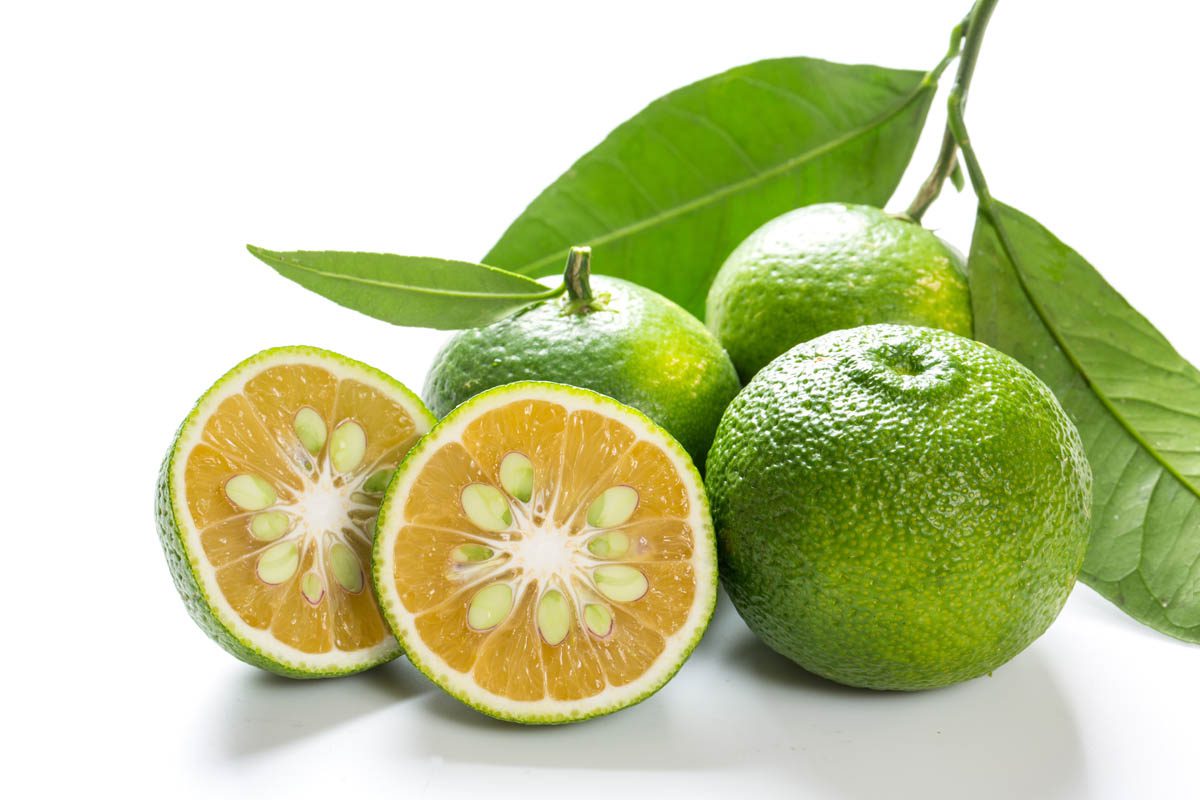 |
| Family: Rutaceae |
| Botanical name: Citrus sudachi Hort. ex Shirai |
| Native to: Japan |
| Common names: Sudachi, Japanese sour citrus |
| Lifespan: Evergreen tree |
| Mature height: 3 – 5 metres |
| Type of citrus: Sour citrus, Japanese fragrant citrus |
| Flower colour: White |
| Leaf colour: Green |
| Fruit colour: Green to orange |
| Bloom time: Spring and summer |
| Soil: Free-draining |
| Humidity: High |
| Propagation: Cuttings |
| Care level: Moderate |
Sudachi is a small, green fruit that weighs about 40 grams, roughly the size of a golf ball. It is famous for its tangy and sour taste and refreshing aroma, which make it a prized ingredient in Japanese cuisine. Sudachi juice is commonly used to enhance the flavour of sashimi, grilled fish, and ponzu sauce, which is a popular dipping sauce made with soy sauce, mirin, and sudachi juice.
The unique aroma of sudachi is due to the presence of limonene and terpene hydrocarbons, which are responsible for its characteristic citrus scent. In addition to its culinary uses, sudachi is also valued for its high levels of vitamin C, making it a popular ingredient in drinks and health supplements.
The name sudachi loosely means ‘vinegar citrus’ and is a contraction of the word sutachibana, which means ‘vinegar Tachibana, which refers to the fruit’s tart and acidic flavour, which is similar to vinegar.
History
Commercial production of sudachi began in the 1960s and with the introduction of greenhouses and long-term cold storage in the 1970s, it became available year-round. The Tokushima Prefecture government even supported local growers of unshu mandarin oranges to switch to sudachi as the price of mandarins had slumped.
The significance of sudachi in Tokushima Prefecture is evident with the designation of its fragrant, white flower as the prefecture flower on October 4, 1974. Sudachi-kun, a citrus-fruit-headed mascot of Tokushima Prefecture, was also developed and introduced at the 48th National Athletic Meet in 1993 and has remained a beloved mascot ever since.
In Kamiyama Town, a 200-year-old sudachi tree still bears fruit, a testament to the resilience and longevity of this citrus fruit.
What is the difference between sudachi, yuzu and kabosu?
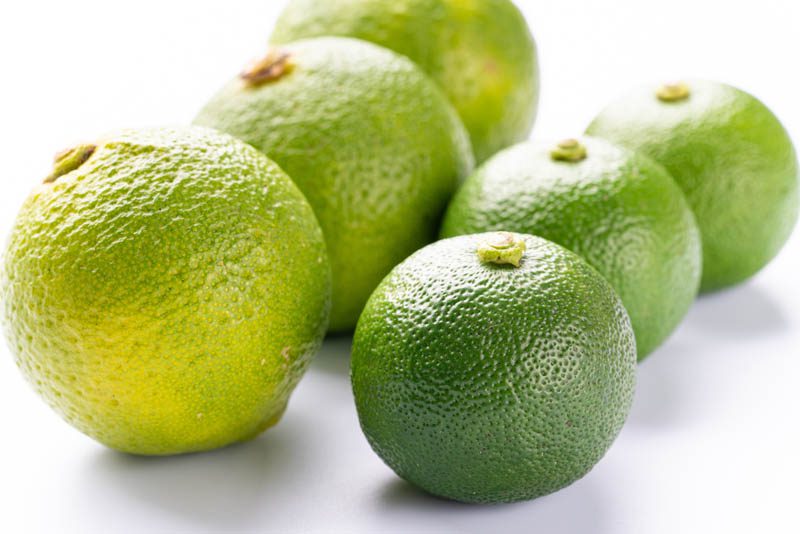
Sudachi is the smallest fruit among sudachi, yuzu and kabosu, with an average width of 4 cm. It has a tart and acidic flavour and is used when still green as a seasoning, garnish and to compliment dishes such as sashimi, grilled fish, and of course ponzu.
Yuzu has a more complex flavour profile with a mix of tartness, bitterness and sweetness. It is used to add a citrus flavour to dishes, sauces, marinades and dressings.
Sudachi is also confused with kabosu due to their similar appearance, however, kabosu, which is cultivated in Oita Prefecture, is considerably larger, weighing in between 80 – 150 grams and approximately the size of a tennis ball.
Despite its lime-like appearance, sudachi is a different species of citrus from lime and is classified as a ‘sour citrus‘, or in Japan, where it, along with yuzu and kabosu, are collectively referred to as Kosan Kankitsu, which means ‘flavorful acid citrus‘.
What does sudachi taste like?
Sudachi is tart and sour with a slightly sweet aftertaste, with a taste often described as a cross between a lime and a grapefruit. The juice is used to enhance the flavour of dishes, and the fruit is generally too tart to eat raw.
Limonin is a compound present in the pulp and peel of sudachi responsible for the bitter taste of sudachi. It is a type of limonoid that acts as a defense mechanism to deter herbivores and insects from feeding on the plant.
What type of citrus is sudachi?
While sudachi has a similar appearance to that of a lime, it is actually a sour citrus, or Japanese fragrant citrus (vinegared mandarin oranges). There are 40 types of Japanese fragrant citrus, including amanatsu, banpeiyu, budoukan, buntan, chukanboke, daidai, mikan, kinkan, okitsu, ponkan, sanbokan, shikwasa and yuzu. These citrus varieties are sour, highly fragrant and typically not eaten raw, but used as seasoning by squeezing the juice into dishes.
Uses
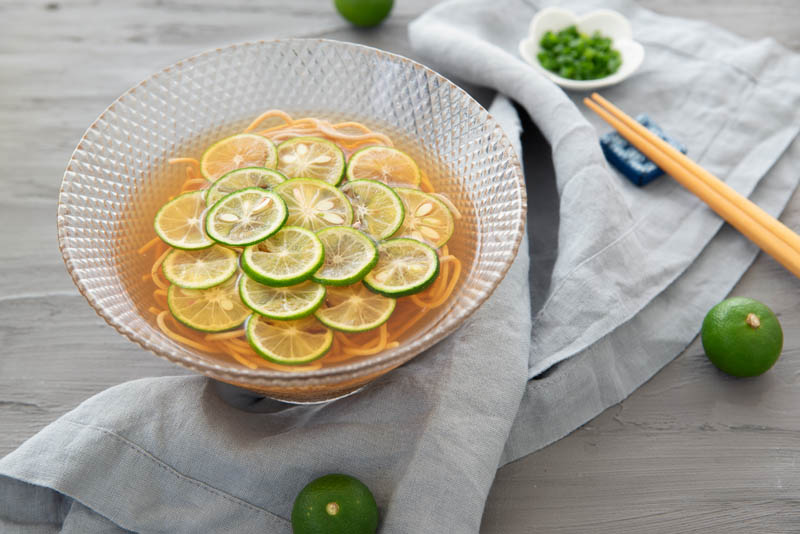
Sudachi is a versatile fruit that can be used in place of lemon or lime to add acidity to dishes. In Japanese cuisine, it is used as a garnish or added to sauces and dressings. Sudachi juice adds tartness to sashimi to compliment the fresh flavour of raw or cooked fish. It can be added to a dipping sauce or garnish for soba and udon noodles as well as tempura and used as a replacement for vinegar. Finely grated or sliced sudachi are served as condiments. In Tokushima Prefecture, sudachi is added to miso soup and sake (Japanese wine) to add flavour.
Ponzu sauce is a popular citrus-based sauce made up of sudachi, yuzu, lime and orange juice, soy sauce, rice vinegar and sugar. It is commonly used as a salad dressing, a dipping sauce or a marinade for chicken or seafood. Sliced sudachi is served with grilled Pacific saury, smoked and fermented skipback tuna (katsuobushi), horse mackerel (aji) and Japanese butterfish (boze).
In recent years, sudachi has also been used in hard candy, gummies and in shochu, a Japanese distilled beverage.
Western uses:
Sudachi peel offers a versatile and zesty addition to a range of culinary creations. When candied, this fragrant peel can be a delicious inclusion in cakes, and muffins, or even used as a topping for fresh yogurt or ice cream. Sudachi can serve as a refreshing substitute for lemons or limes in cooked fish, offering a unique flavour profile to meringue pies, marmalades, and sorbets.
For an Italian-inspired twist, Sudachicello (a Sudachi-based limoncello) can be a delightful addition to any liquor cabinet, while sliced and dried wheels can infuse alcoholic and non-alcoholic beverages with a subtle yet tangy citrus flavour. For a finishing touch on sashimi, combining the dried peel with salt produces a distinctively flavoured seasoning.
Sudachi recipes
Sudachi Citrus Salad Dressing |
Ingredients:
Instructions:
Notes: Serve with chicken or fish. |
Sudachi Marinated Grilled Chicken |
Ingredients:
Instructions:
Notes: Serve with steamed rice, steamed vegetables, Asian coleslaw, noodles and cucumber salad. |
Sudachi Citrus Vinaigrette |
Ingredients:
Instructions:
|
Sudachi Citrus Salsa |
Ingredients:
Instructions:
|
Sudachi Citrus Pie |
Ingredients:
Instructions:
|
Sudachi Ceviche |
Ingredients:
Instructions:
|
Sudachi Glazed Salmon |
Ingredients:
Instructions:
|
Sudachi Citrus Cooler |
Ingredients:
Instructions:
|
Sudachi Citrus Sorbet |
Ingredients:
Instructions:
|
Sudachi Citrus and Soy Glazed Pork Chops |
Ingredients:
Instructions:
|
How to store sudachi
Store sudachi in a plastic bag in the crisper compartment of your fridge between 2 – 5°C. The skin may turn yellow, and the aroma and flavour may slightly decrease, however, this will have no impact on the taste. Sudachi can be juiced and stored in ice cube trays.
Where is sudachi grown?
Sudachi is primarily grown in Japan, particularly in the Tokushima prefecture on the island of Shikoku, where it is considered a specialty crop. Tokushima Prefecture accounts for approximately 98% of sudachi production, with Tokushima City, Kamiyama Town, Sanagochi Village and Anan City as the main producers. Sudachi is available year-round in Japan, outdoor grown sudachi flowers from May to June, and the fruit is harvested when unripe, between the months of August and November. Sudachi is also grown in large greenhouses to provide fruit year-round. Due to its delicate nature, the fruit is harvested by hand.
Sudachi is graded according to rind quality, blemishes and size. Grade A is the highest, followed by B and C. Some fruit is ‘ungraded’ which means it has not been graded. Greenhouse-grown sudachi (house sudachi) is said to have thinner skin and less aroma than sudachi grown outdoors (outdoor sudachi or roji sudachi). There are four sudachi sizes; L, 2L and 3L. L is the largest, and 3L the smallest, 2L is the most popular size.
Despite its popularity in Japan, sudachi is still relatively unknown outside of Japan and is considered a speciality fruit. However, it is slowly gaining the attention of chefs around the world. Currently, sudachi is cultivated in California, United States and Piura, Peru. Hopefully, this fruit will become more readily available outside Japan as interest and demand increase.
Health benefits of sudachi
Not only does sudachi taste great, it also contains a number of important phytochemicals that are great for our health. Sudachi is is rich in ascorbic acid (vitamin C), essential for boosting the immune system and maintaining skin health. Antioxidants protect the body against cellular damage and reduce inflammation.
Sudachitin is a polymethoxyflavone (special flavonoids in citrus fruits) isolated from the peel of sudachi that has been found to induce apoptosis (programmed cell death) in HaCaT cells, which raises the potential to be developed into drugs to treat various skin diseases. Another study found sudachitin inhibited the proliferation of a wide range of tumour cells, including liver, cholangiocarcinoma, pancreatic and colorectal cancers.
Sudachi is a rich source of polyphenols, which are plant-based compounds that have antioxidant and anti-inflammatory properties. Polyphenols protect the body against cell damage caused by free radicals which can cause cancer, heart disease and Alzheimer’s disease. Several types of polyphenols are present in sudachi including flavonoids, coumarins and limonoids. Flavonoids are a group of polyphenols that have anti-inflammatory, anti-cancer and anti-diabetic properties. Coumarins have been shown to have anti-tumour and anti-inflammatory properties. Finally, limonoids have been found to have anti-cancer properties.
One study involving 40 adults found that powdered sudachi peel significantly reduced triglyceride levels, body weight and waist circumference in participants with levels over triglyceride levels over 120 mg/dl.
Where to buy sudachi
Sudachi fruit is still almost impossible to purchase outside Japan, however, specialist nurseries sometimes have grafted sudachi trees for sale. It typically takes an immature citrus tree 3-4 years before it begins to produce harvestable fruit. Before this, any developing fruit should be removed to allow the tree to focus its energy on growing and not fruit production.
How to grow sudachi
| Position | Sudachi likes a minimum of six hours of sunshine a day, in a sheltered position, away from strong winds. |
| Water | Water deeply when the top 5 cm (2 inches) twice a week, or more in hot weather. |
| Soil | Sudachi trees need well-draining soil with a pH range of 6.0 to 7. They like moist soil, rich in organic matter, but overly wet or waterlogged soil can cause root rot. Sand or loam soils are ideal for citrus, if the soil is too heavy, add compost and gypsum. |
| Fertilisation | Feed your sudachi with a good quality slow-release citrus fertiliser three times a year at the start of spring, summer and autumn. |
| Mulch | Apply a 5 cm layer of mulch around the drip line of the citrus to retain moisture and keep weeds away. Do not apply directly around the trunk to prevent collar rot. |
Notes:
Sudachi grows in similar conditions to other citrus varieties. As a tropical plant, citrus grows best in temperate to tropical climates and is not frost-hardy. Sudachi can be grown in the ground or in containers that are a minimum of 40 cm wide. Bear in mind that citrus grown in pots will produce considerably less fruit than those grown in the ground.
Sudachi can grow in cooler climates but must be brought indoors or placed in a greenhouse during the cooler months as it is not frost-hardy.
As a shallow-rooted tree, sudachi doesn’t like other plants around the root ball. Therefore it is important to remove weeds as they appear and mulch well.
Sudachi trees are grafted onto rootstock, occasionally suckers will develop below the graft which should be cut off as they take up nutrients and water from the grafted portion (scion).
Julia is a writer and landscape consultant from Wollongong with a love of horticulture. She had been an avid gardener for over 30 years, collects rare variegated plants and is a home orchardist. Julia is passionate about learning and sharing her knowledge of plant propagation and plant toxicology. Whether it’s giving advice on landscape projects or sharing tips on growing, Julia enjoys helping people make their gardens flourish.
